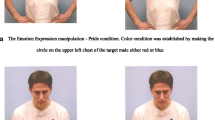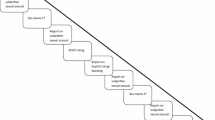Abstract
Male undergraduate students were randomly assigned to experimental conditions designed to induce feelings of success, failure, or uncertainty as to their performance on ambiguous outcome tasks described as measures of intelligence. Subjects’ attitudes toward an attractive female confederate encountered in a subsequent interview-like situation partially supported the “warm glow” hypothesis whereby success is expected to facilitate positive response dispositions toward others. Successful subjects expressed significantly stronger liking for the confederate and greater likelihood of asking her for a date than did failure subjects or uncertainty controls. But when she was presented in a physically unattractive way, just the opposite results were obtained. Methodological and theoretical issues are considered in discussing directions for multivariate research into trait and situational determinants of the interpersonal effects of success and failure.
Similar content being viewed by others
References
BERSCHEID, E., & WALSTER, E. 1974. Physical attractiveness. In L. Berkowitz (Ed.), Advances in experimental social psychology (Vol. 7). New York: Academic Press.
DEAUX, K, & FARRIS, E. 1977. Attributing causes for one’s own performance: The effects of sex, norms, and outcomes. Journal of Research in Personality, 11, 59–72.
DOMINOWSKI, R.L. 1966. Anagram solving as a function of letter moves. Journal of Verbal Learning and Verbal Behavior, 5, 107–111.
DUNCAN, D.B. 1955. Multiple range and mulitple F tests. Biometrics, 11, 1–42.
FEATHER, N.T., & SIMON, J.G. 1971. Attribution of responsibility and valence of outcome in relation to initial confidence and success and failure of self and other. Journal of Personality and Social Psychology, 18, 173–188.
FITCH, G. 1970. Effects of self-esteem, perceived performance, and choice on causal attributions. Journal of Personality and Social Psychology, 16, 311–315.
FONTAINE, G. 1975. Causal attribution in simulated versus real situations: When are people logical, when are they not? Journal of Personality and Social Psychology, 32, 1021–1029.
FRIEZE, I., & WEINER, B. 1971. Cue utilization and attributional judgments for success and failure. Journal of Personality, 39, 591–605.
GOUAX, C. 1971. Induced affective states and interpersonal attraction. Journal of Personality and Social Psychology, 20, 37–43.
GRIFFITT, W.B., & GUAY, P. 1969. ’Object’ evaluation and conditioned affect. Journal of Experimental Research in Personality, 4, 1–8.
GRIFFITT, W.B., MAY, J., & VEITCH, R. 1974. Sexual stimulation and interpersonal behavior: Heterosexual evaluative responses, visual behavior, and physical proximity. Journal of Personality and Social Psychology, 30, 367–377.
HORN STEIN, H.A. 1976. Cruelty and kindness: A new look at aggression and altruism. Englewood Cliffs, New Jersey: Prentice-Hall.
HOUSE, W.C., & PERNEY, V. 1974. Valence of expected and unexpected outcomes as a function of locus of control and type of expectancy. Journal of Personality and Social Psychology, 29, 454–463.
ISEN, A.M. 1970. Success, failure, attention, and reaction to others: The warm glow of success. Journal of Personality and Social Psychology, 15, 294–301.
ISEN, A.M., & LEVIN, P.F. 1972. Effects of feeling good onhelping: Cookies and kindness. Journal of Personality and Social Psychology, 3, 384–388.
JONES, S.C., & SHRAUGER, J.S. 1968. Locus of control and interpersonal evaluations. Journal of Consulting and Clinical Psychology, 32, 664–668.
KIESLER, S.B., & BARAL, R.L. 1970. The search for a romantic partner: The effects of self-esteem and physical attractiveness on romantic behavior. In K.J. Gergen & D. Marlowe (Eds.), Personality and social behavior. Reading, Mass.: Addison-Wesley.
KRECH, D., CRUTCHFIELD, R.S., & BALLACHEY, E.L. 1962. Individual in society. New York: McGraw-Hill.
LUGINBUHL, J.E.R. 1972. Role of choice and outcome on feelings of success and estimates o f ability. Journal of Personality and Social Psychology, 22, 121–127.
LUGINBUHL, J.E.R., CROWE, D.H., & KAHAN, J.P. 1975. Causal attributions for success and failure. Journal of Personality and Social Psychology, 31, 86–93.
MARACEK, J., & METTEE, D.R. 1972. Avoidance of continued success as a function of self-esteem, level of esteem certainty, and responsibility for success. Journal of Personality and Social Psychology, 22, 98–107.
MCMAHAN, D. 1973. Relationships between causal attributions and expectancy of success. Journal of Personality and Social Psychology, 28, 108–114.
NICHOLLS, J.G. 1975. Causal attributions and other acheivement-related cognitions: Effects of task outcomes, attainment value, and sex. Journal of Personality and Social Psychology, 31, 379–389.
PELLEGRINI, R.J., HICKS, R.A., MEYERS-WINTON, S., & ANTAL, B.G. 1978. Physical attractiveness and self-disclosure in mixed-sex dyads. The Psychological Record, 28, 509–516.
PHARES, E.J. 1976. Locus of control in personality. Morristown, N.J.: General Learning Press.
SCHACHTER, S., & SINGER, J. 1962. Cognitive, social, and physiological determinants of emotional state. Psychological Review, 69, 379–399.
STEPHEN, W., BERSCHEID, E., & WALSTER, E. 1971. Sexual arousal and heterosexual perception. Journal of Personality and Social Psychology, 20, 93–101.
THOKNDIKE, E.L., & LORGE, I. 1944. The teacher’s word book of 30, 000 words. Columbia University Bureau of Publications.
WEINER, B., FRIEZE, I., KUKLA, A., REED, L., REST, S., & ROSENBAUM, R.M. 1971. Perceiving the causes of success and failure. Morristown, N.J.: General Learning Press.
ZUCKERMAN, M., & ALLISON, S.N. 1976. An objective measure of fear of success: Construction and validation. Journal of Personality Assessment, 40, 422–430.
Author information
Authors and Affiliations
Additional information
This research was supported in part by a grant to the first author from the San Jose State University Foundation.
Rights and permissions
About this article
Cite this article
Pellegrini, R.J., Hicks, R.A. & Meyers-Winton, S. Situational Affective Arousal and Heterosexual Attraction: Some Effects of Success, Failure, and Physical Attractiveness. Psychol Rec 29, 453–462 (1979). https://doi.org/10.1007/BF03394635
Published:
Issue Date:
DOI: https://doi.org/10.1007/BF03394635




